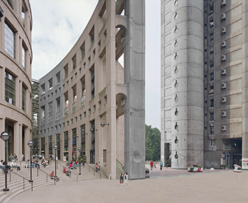Within the ongoing project Boulevards, Banlieues and Other Samples of Decorated Histories(since 2005 ongoing) Bitter/Weber juxtapose and merge icons of postmodern architecture in large-scale photo collages. Postmodern buildings from different, or even contradictory, economies and sites locate postmodern architecture as an aspect of globalized cities: Ceausescu’s boulevard in Bucharest bends into a social housing project by Ricardo Bofill in the banlieues on the outskirts of Paris; the Genex Tower in post-socialist Belgrade merges into Moshe Safdie’s post-modern public library of Vancouver.
The Genex Tower, also refered to as the Gate, is a 35 story skyscraper realized in 1980 by Mihajlo Mitrovic. This tower, which is a distinctive twin tower joined by an awkward bridge near the apex, serves as an entry point to Novi Beograd (New Belgrade), a planned city across the river from Belgrade designed as the new capital of Tito’s nonaligned Yugoslavia. Genex, originally a state-owned enterprise for import and export, was part of the mixed socialist and market socialist economy of Yugoslavia; since the split up of the Federal Republic of Yugoslavia, Genex, and other state industries, have come under global capital’s pressure to privatize state holdings and public goods.
Following the privatization of the modernist Vancouver Public Library (VPL) at the commercially dense corner of Burrard and and Robson streets, the new VPL was built by Moshe Safdie in 1995 as an architectural statement of public interest and as a representation of new forms of the public-private sphere. Despite its public function, the VPL also serves as an anchor to the gentrification of Yaletown, one of Vancouver’s most thriving and globally generic private real estate developments.
In the his essay, „The Return of Postmodernism“, Clint Burnham focusses on the reading of the buildings through the Fredric Jameson’s concept of the Hypercrowd and its meaning for architecture and the constitution of agency. While postmodern theoreticians generally conceived of Modernity as failed project and a “grand narrative" never able to legitimate itself, postmodernism was seen as a period initiating the “end of the grand narrative" and the rise of particular histories and identities.
Belgrade/Vancouver questions this narrative and propagates a symbolic economy of postmodernism to examine postmodern architecture as a phenomenon of globalisation.
Credits:
The print project Belgrade/Vancouver was realized for the exhibition Architecture and Disaster curated by Candice Hopkins at the Western Front. the poster designed by Mark Soo.
The Belgrad images are part of the ongoing project Differentiated Neighbourhoods, curated by Zoran Eric of the Museum of Contemporary Art, Belgrade.
Thanks to Jeff Derksen.
|
|

